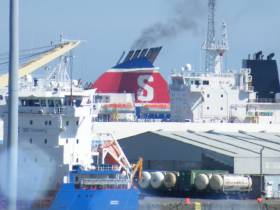Displaying items by tag: €320m expansion
Port of Dublin Seek Planning Permission for €320m Expansion
The Dublin Port Company is seeking planning permission for an estimated €320 million worth of projects that make up the second stage of its main expansion plan.
The State-owned company, writes The Irish Times, is working on a masterplan that will bring it to “its maximum and ultimate capacity” by 2040, according to its chief executive, Eamonn O’Reilly.
The company said on Tuesday that it has asked An Bord Pleanála for permission to go ahead with the second stage of the plan, which involves five key projects scheduled to be finished by 2035.
“If we were building all of it today it would cost us €320 million,” Mr O’Reilly estimated. He cautioned that it would not be possible to give a final figure until Dublin Port knew what conditions could be attached to any planning permission it received and had calculated for both detailed design and construction inflation.
The company’s board recently approved a proposal to allow it borrow an extra €300 million if needed.
The masterplan’s second stage (MP2 Project) provides for a new roll-on roll-off jetty for ferries up to 240m-long, lengthening an existing berth for container ships, redeveloping an oil berth so it can handle container traffic, re-orienting another existing berth and consolidating passenger terminals.
For more including the company's consultation process click this link.
In addition Afloat.ie adds DPC has announced is lodging an application for permission with An Bord Pleanála for its MP2 Project, the second major capital development project from the Port’s Masterplan 2040.
It follows consultation with stakeholders, including the local community, customers, State agencies, Government departments and other public bodies.
Public information days (see below) will be held in local communities over the coming weeks with details of the proposed development plans on view.
Additional Capacity for Future Growth
The MP2 Project is the second of three Strategic Infrastructure Development projects required to deliver the vision of Masterplan 2040. This vision sees Dublin Port reaching its ultimate capacity by 2040 with no additional infill of Dublin Bay. The need now for the MP2 Project arises from both the level of future growth DPC is projecting and the time required to complete the development works (2020 – 2035).
By reconfiguring how existing facilities and lands are currently used, the MP2 Project will create additional capacity for almost one-third of the projected increases in Dublin Port’s Ro-Ro (truck) and Lo-Lo (container) traffic between now and 2040.
When complete, the MP2 Project will also increase Dublin Port’s capacity to handle growing ship sizes by providing up to three longer, deeper river berths capable of taking Ro-Ro ferries and Lo-Lo container ships measuring up to 240m in length.
Port Heritage & Community Gain
The MP2 Project also includes provision for a publicly accessible Heritage Zone at the eastern end of the Port.
This will include a new structure or ‘Marker’ incorporating the original lighthouse bell and lantern from the pier head at the end of the long gone 19th century eastern breakwater. The Marker includes a Viewing and Interpretive Deck, and beneath it a small performance space or amphitheatre. The proposal also features the installation of a Sea Organ, a musical instrument made from a series of pipes with whistle openings installed into the land boundary. The Heritage Zone will be accessible by cyclists and pedestrians along the new 4km greenway on the northern fringe of the port overlooking the Tolka Estuary. Construction of the greenway will commence later this year.
In the event that permission is granted for the MP2 Project, a Community Gain initiative is also proposed as part of the application that would see DPC establish a €1 million trust fund for Dublin City Council to develop a city farm in the vicinity of the Port, intended to enhance the local community and benefit the wider city through educational, volunteering and collaboration opportunities. In addition, DPC would establish a €1 million trust fund for St. Joseph’s Co-Ed Primary School in East Wall, intended to benefit the school community closest to the development site.
Public Consultation
The application for permission, the Environmental Impact Assessment Report and the Natura Impact Statement, will be available to inspect during public opening hours for seven weeks from 19th July 2019 at: -
- The Offices of An Bord Pleanála 64 Marlborough Street, Dublin 1.
- The Offices of Dublin City Council, Civic Offices, Woodquay, Dublin 8.
- The Offices of Dublin Port Company, Port Centre, Dublin Port, Alexandra Road, Dublin 1.
The application may also be viewed / downloaded from the project website: www.dublinportmp2.ie (which at timing of writing is 'coming soon').
Public Information Days will also take place in the following locations, where the MP2 Project Team will be available to discuss the project in person and where the application documents will be on view.
|
CLONTARF |
Scoil Uí Chonaill GAA Club, 95 Clontarf Road |
Tuesday, 23rd July, 2019 |
2-8pm |
|
EAST WALL |
Seán O'Casey Community Centre, St. Mary’s Road |
Wednesday, 24th July, 2019 |
2-8pm |
|
RINGSEND |
Clanna Gael Fontenoy GAA Club, Sean Moore Road |
Thursday, 25th July, 2019 |
2-8pm |
Submissions or observations may be made only to An Bord Pleanála up until 5.30pm on 5th September 2019. See www.pleanala.ie for further details.
























































